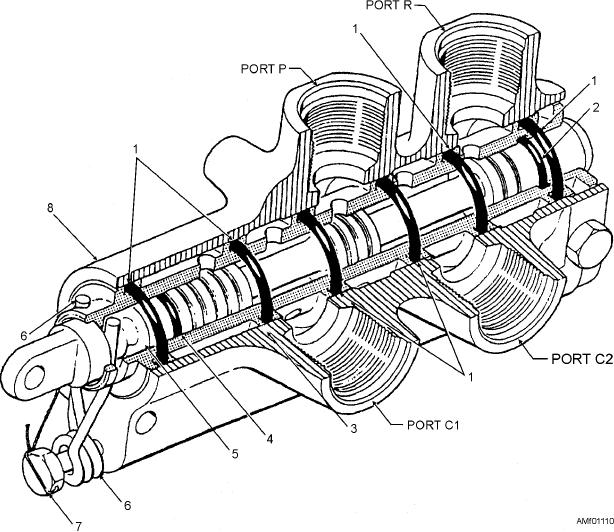
one return poppet. See figure 11-9. The valve is now in
lobe operates the two return poppets. To stop the
rotation of the camshaft at an exact position, a stop pin
a working position. Pressure fluid, entering the
is secured to the body, and extends through a cutout
pressure port, travels through the vertical fluid
section of the camshaft flange. This stop pin prevents
passages in both pressure poppet seats. Since the cam
overtravel by ensuring that the cam lobes stop rotating
lobe unseats only one pressure poppet, the pressure
when the poppets have been unseated as high as they
fluid flows past this open poppet to the inside of the
can go, where any further rotation would allow them to
poppet seat. From there it flows out the diagonal fluid
return to their seats.
passages, and then out one cylinder port and to the
T h e p o p p e t - t y p e s e l e c t o r va l ve h a s t h r e e
actuator.
positions--neutral and two working positions. In the
Return fluid coming from the actuator is coming in
neutral position, the camshaft lobes are not contacting
the other cylinder port, through the diagonal fluid
any of the poppets. This position assures that the
passages, past the unseated return poppet, through the
poppet springs will hold all four poppets firmly seated.
vertical fluid passages, and out the return port to the
With all poppets seated, there is no fluid flow through
system reservoir. By rotating the camshaft in the
the valve. This action also blocks the two cylinder
opposite direction until the stop pin hits, the opposite
ports, so when this valve is in neutral, the fluid in the
pressure and return poppets are unseated, and the fluid
unit system is trapped. To allow for thermal expansion
flow is reversed. This causes the actuator to move in
buildup, thermal relief valves must be installed in both
the opposite direction.
working lines.
Selector valves should be checked periodically for
You can rotate the camshaft by moving the control
leakage and security of mounting. The operating
handle in either direction from neutral. This action
linkage should be inspected for ease of operation.
rotates the lobes, which unseat one pressure poppet and
Figure 11-9.--Working view of a poppet-type selector valve.
11-10

